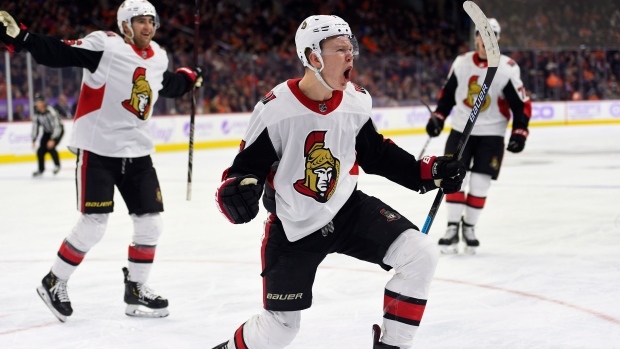Apr 9, 2020
A look at the best low-slot shooters in hockey
Senators winger Brady Tkachuk has joined Montreal’s Brendan Gallagher in the top tier of NHL forwards successfully making a living in the low slot, Travis Yost writes.
By Travis Yost

For years, Montreal winger Brendan Gallagher has been renowned for two things – an ability to generate a high volume of shots and an ability to generate those shots from dangerous scoring areas.
Those two skills alone have made him, despite his diminutive frame, one of the more productive and reliable scoring forwards in all of hockey.
Gallagher isn’t the first forward to make a living in the low slot, and he won’t be the last.
Not every player in the league is blessed with Ilya Kovalchuk’s, Patrik Laine’s or Auston Matthews’ level of speed and accuracy with wrist shots and slapshots. But every forward has some degree of scoring expectation on him, and being productive without being able to pick corner after corner from anywhere on the ice can be a challenge.
That said, Gallagher merely has a different skill. It is comparably difficult to pierce the interior of the defence so frequently, and getting shots out of scrambles or off rebound opportunities is always a challenge.
Think of the lower-body strength required to fight off defenders in every one of these scrums, and think about the mental challenge of knowing that the type of offensive game you are playing – one that sees you fighting in front of the net every shift – increases the wear and tear on your body and comes with an increased risk of injury.
But if you want to score more – save for the elite snipers of the world – you simply have to cut down the distance from which you are shooting. The relationship between shot distance and scoring rates is significant, and any logistic regression will show you that:

If you were looking for a valuable shooting distance, 15 feet and in probably applies. At 15 and in (all other variables left “unknown” for the time being), you see intersection with league average shooting percentage around 8 per cent. The closer you get to the net, the better the chance of you scoring
That brings us to this year’s leaderboard. Gallagher, who has held a spot on the “15-and-in” Mount Rushmore for years now, was dethroned by a Canadian rival – Ottawa’s Brady Tkachuk.
Gallagher ended up playing 12 fewer games than Tkachuk, which explains most of the gap, but on a per-game basis their production from in close is almost identical. That’s good news for Ottawa fans, considering Gallagher’s track record.
Also of note? The other Tkachuk (Calgary’s Matthew) is also quite good at this, as are the top-six forwards in Toronto and Vegas:

It’s interesting that you can draw a line between individuals who are elite at driving to the front of the net and high-end teams who have ease generating scoring chances from in close.
There is little doubt that players like Gallagher and Tkachuk (or both Tkachuk brothers for that matter) have a unique skill at pressing into the low slot. But there is something to be said for players who can get the pucks to teammates in front of the net, too.
Look what happens when a Maple Leafs forward – regardless of their competency – gets to play with a dynamic playmaker like Matthews. Or look at what happens when you have players like Paul Stastny and Max Pacioretty getting to work in spots with a similarly dynamic Mark Stone.
Every team is looking for great individual talent, but it is always worth remembering that complementary skill sets in a team sport like hockey can yield similar results, too.
Which leaves us with something quite scary to think about: What happens if Montreal and Ottawa find even more capable centres to create passing and shooting lanes for players like Gallagher and Tkachuk?
Gallagher has been driving his line for quite some time, and Tkachuk entered the league on a team in the middle of a complete rebuild. More capable playmaking talent around players like this could pay dividends in the future.
The burden to find those pieces falls on the shoulders of Marc Bergevin and Pierre Dorion, who will no doubt be busy this summer as they continue to shape their rosters.
Data via Natural Stat Trick, Evolving Hockey, NHL.com


